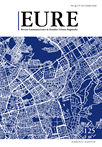The decline of the urban in Santiago, Chile
DOI:
https://doi.org/10.4067/S0250-71612016000100003Keywords:
urban periphery, segregation, social inequalityAbstract
This article presents some results of an investigation whose objective was to revise the spatial manifestations of the urban weakening process in Santiago, Chile. For this, LefebvreÍ€™s theory of the social production of space is addressed as a starting point, emphasizing its subjective dimension. This framework allows organizing the available information relative to Santiago and establishing that this is a city where social gaps are evidenced concomitant to the hierarchical order of its diverse municipalities. In order to further analyse the subjective aspects of this spatial production, a theoretical multidisciplinary framework is applied, developing concepts elaborated by Heller, Lechner, Soja and Foucault. The conclusion points that the subjective dimension of the spatial production is found in the development of counterspaces and counterbehaviors by those who live in the periphery, as processes that materialize in the creation of transmissible sets of norms that allow certain freedom of action in an unequal city.Downloads
Published
How to Cite
Issue
Section
License
Copyright (c) 2015 Revista EURE - Revista de Estudios Urbano Regionales

This work is licensed under a Creative Commons Attribution 4.0 International License.
Al momento de aceptar la publicación de sus artículos, los autores deberán formalizar la cesión de derechos de autor a EURE, según las condiciones establecidas por la Revista.
Ésta establece que el autor autoriza a EURE de manera gratuita, exclusiva e ilimitada a reproducir, editar, publicar, distribuir, publicitar, comercializar y traducir el artículo, a cualquier soporte conocido o por conocer y desarrollar.
Del mismo modo, los autores aseguran que el artículo propuesto es original, no publicado y no propuesto para tal fin a otro medio de difusión.


